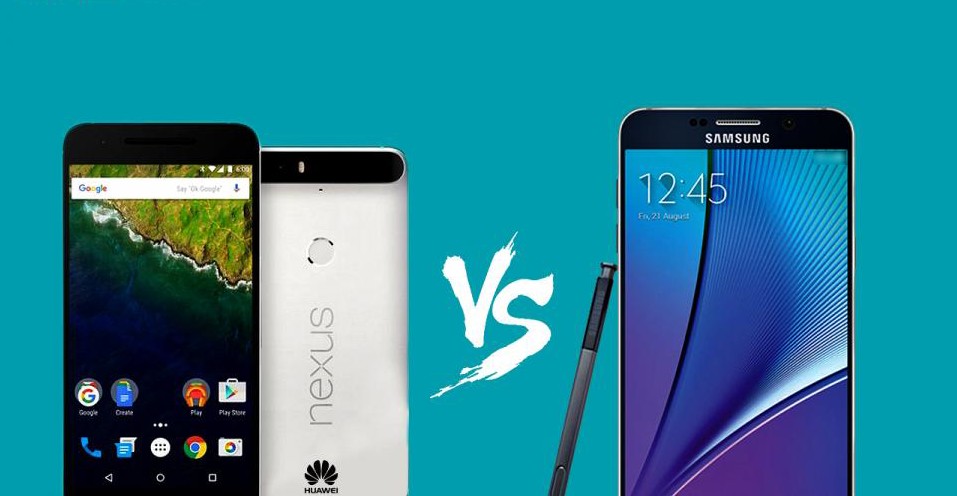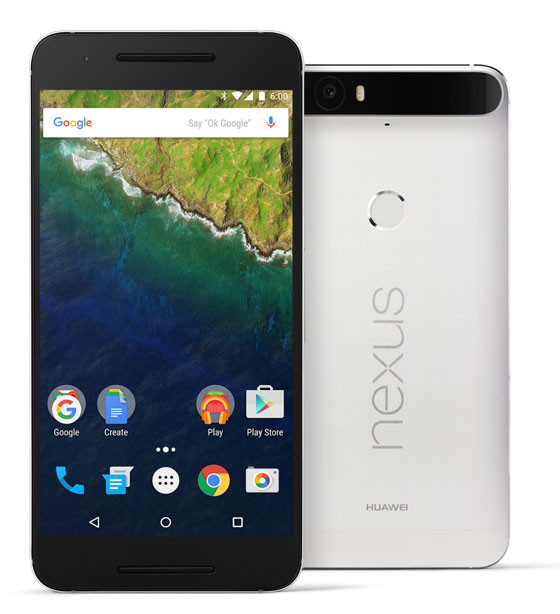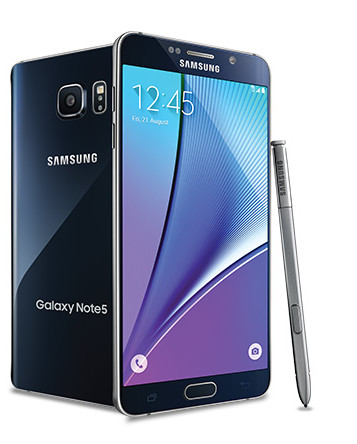The Nexus 6p and Samsung’s Note 5 are two of the greatest flagship phablets that hit the market during the fall of 2015. Every company tries to outdo with each top of the line mobile device that it launches. Sometimes with a lot of hard work and vision, new devices push the industries limits further with new hardware or software features. Two of the most recognized devices available in the world are Samsung phones, which cover a wide pallet of devices from entry-level devices to high-end flagship phablet and there is Google, a company that contract mobile phone makers to produce Nexus phones that run pure Android OS.
NEXUS 6p
There is a clear demand for phablet phones on the market and Google made a successor to Motorola’s Nexus 6, the 6p made by Huawei with a 5.7″ screen. They reduced the screen’s size from 6″ to 5.7″ a size that is better for single-hand use. Teaming up with Huawei Google tried to create a premium phone that improves all of Nexus’s previous weak points.
From the beginning, we see that Huawei stepped up the game and encased the new Nexus in a gorgeous metal unibody that gives the device a premium look and feel. It’s by far the best looking Nexus phone yet, the design is clean, with all the buttons on the right side, the power button has a textured finish and they have a nice feel with a pleasant feedback when pressed. The 3.5 mm jack sits at the top and at the bottom we find the new USB Type-C port. This new type of cable brings a lot of features like quick charging, but at the moment it’s a bit of a hustle because of its rarity. Google didn’t help when they added a USB Type-C to Type-C in the box, instead of adding another USB Type-C to Type-A for connecting to a computer.
The front of the 6p is dominated by the impressive 5.7″AMOLED screen and has a 71.4 % screen to body ratio. Above the screen, we see a front facing 8MP camera sensor and a loudspeaker. Under the screen sits another speaker giving us a very nice stereo sound experience. I am a big fan of stereo front speakers, it’s a design element that looks amazing and is very practical. The back of the new 6p features a “Huawei” horizontal logo, a “Nexus” vertical logo, this time painted not the device. As we move to the top of the device we find the new features, a fingerprint scanner and a black glass bar that houses the main 12MP camera sensor, the laser autofocus, and the flash LED.
The display is a 5.7″ touchscreen with Quad HD resolution at 2560 x 1440 pixels with a pixel density of 518 ppi. QHD has become a standard for premium devices and the AMOLED technology offers am amazing visual experience, the deep black creates a very high contrast level and the color pop out nicely. As in the case of most QHD displays, the brightness level can be very high and the images are very sharp and clear.
The hardware is what we can expect from a premium flagship of 2015, the 6p has the Snapdragon 810 chipset, which comes with an octa-core CPU clocked at 2 GHz, the Adreno 430 GPU, and 3 GB of RAM. This hardware package makes gaming, multitasking, and navigating through the menus run smooth with no lag. There is no external memory support, but the device comes in 3 storage space variants, 32 GB, 64 GB and 128 GB. The powerful 3450 mAh battery combined with Android’s 6.0 power saving tweaks will keep this flagship running at least a full day with mixed use. Google showed that for apps to run smooth a device needs more the pure calculating power, it also needs a well optimized OS. Normally, the pure Android experience plays a major role in the Nexus’s success. The Nexus 6p and the smaller 5x come with the latest version of Android that brings improvements in power saving and privacy.
KEY FEATURES
- CPU – Quad-core 1.55 GHz Cortex-A53 & Quad-core 2.0 GHz Cortex-A57/Qualcomm MSM8994 Snapdragon 810
- GPU – Adreno 430
- DISPLAY – Corning Gorilla Glass 4, 5.7 inches, AMOLED capacitive touchscreen, 16M colors, 1440 x 2560 pixels (~518 ppi pixel density)
- MEMORY – 32/64/128 GB, 3 GB RAM, no card slot
- BATTERY – Non-removable Li-Po 3450 mAh battery
- CAMERA –12 MP, 4608 x 2592 pixels, laser autofocus, dual-LED (dual tone) flash; Secondary camera 8 MP, 720p@30fps
- VIDEO – 2160p@30fps
- BODY – 159.3 x 77.8 x 7.3 mm (6.27 x 3.06 x 0.29 in)
- WEIGHT – 178 g (6.28 oz)
- WIRELESS – Wi-Fi 802.11 a/b/g/n/ac, dual-band, Wi-Fi Direct, DLNA, hotspot
Samsung Galaxy Note 5
The Galaxy Note 5, released in the summer is clearly a step forward compared to the galaxy Note 4. Although it still keeps Samsung’s specific shape, the Galaxy Note 5’s design is smoother and more appealing than its predecessor’s. Its screen- to- body ratio was increased and it’s also slimmer and lighter than the Galaxy Note 4.
The metal unibody and Gorilla Glass 4 cover not only makes the GalaxyNote 5 look good, it also confers a premium feel to it. The Galaxy Note 5 features a physical home button on the lower edge of the device, alongside two capacitive buttons that are meant to ensure easy access to some features of the smartphone. It is equipped with a 5.7- inches, Super AMOLED touchscreen which was improved in terms of color saturation and brightness. Due to the 1440 x 2560 pixels resolution and 518 ppi pixel density the display of the Note 5 will deliver crisp and clear images.
The Galaxy Note 5 comes with the S Pen stylus. The S Pen slides out from the bottom of the phone’s frame if you click it. Users can write down anything when using the smartphone phone by enabling “Screen off memo” in settings. All that users write will be saved in the S notes app. Although it may not be everyone’s cup of tea to be able to write on their smartphones, probably for some people it will be a great extra feature the Galaxy Note 5 has to offer.
The Galaxy Note 5 currently runs on Android 5.1.1 Lollipop- based TouchWiz UI and will probably get the Android 6.0 Marshmallow update in the near future. It is powered by an Exynos 7420 chipset and boasts a Quad-core 1.5 GHz Cortex-A53 and a Quad-core 2.1 GHz Cortex-A57 processor. The GPU of the Galaxy Note 5 is a Mali-T760MP8. As far as memory and storage go, the Galaxy Note 5 includes 4 GB of RAM and can be purchased in a 32 GB and in a 64 GB storage version. Unfortunately, there is no microSD card slot, so the storage of the Galaxy Note 5 is not extendable.
The Galaxy Note 5 comes with a 13 MP back camera with 5312 x 2988 pixels, optical image stabilization, autofocus and LED flash. The camera features include dual shot, Simultaneous HD video and image recording, geo-tagging, touch focus, face detection, panorama, and HDR. All these features come together in delivering extremely high-quality pictures. The camera of the Galaxy Note 5 is able to record 2160p@30fps and 1080p@60fps videos. The secondary camera of the Galaxy Note 5 is a pretty common 5 MP one.
KEY FEATURES
- CPU – Quad-core 1.5 GHz Cortex-A53 & Quad-core 2.1 GHz Cortex-A57 /Exynos 7420
- GPU – Mali-T760MP8
- DISPLAY – Corning Gorilla Glass 4, 5.7 inches, Super AMOLED capacitive touchscreen, 16M colors, 1440 x 2560 pixels (~518 ppi pixel density)
- MEMORY – 32/64 GB, 4 GB RAM, no card slot
- BATTERY – Non-removable Li-Po 3000 mAh battery
- CAMERA –16 MP, 5312 x 2988 pixels, optical image stabilization, autofocus, LED flash,; Secondary camera 5 MP
- VIDEO – 2160p@30fps, 1080p@60fps, optical stabilization, dual-video rec
- BODY – 153.2 x 76.1 x 7.6 mm (6.03 x 3.00 x 0.30 in)
- WEIGHT – 171 g (6.03 oz)
- WIRELESS – Wi-Fi 802.11 a/b/g/n/ac, dual-band, Wi-Fi Direct, hotspot
Overall the two flagships have some similar features like the AMOLED screen size, resolution, and pixel density. Both have an aluminum frame and their weight is similar, the 6p has 178 g and the Note 5 has 171 g. Neither have external memory support. The fingerprint scanner is present on both devices, but the Nexus has it on the back, under the camera where it can be easily pressed while holding, this way you can unlock the device while you are lifting it or pulling out of a pocket. The Note’s 5 fingerprint scanner is embedded in the home screen like we see in most smartphones with this technology.
There are plenty of differences between these devices and these are the aspects users consider when choosing what they want. The major differences are regarding storage space, the Note 5 has only 2 variants 32 and 64 GB. The Note 5 wins points with the superior 4 GB of RAM, the 16 MP main camera, wireless charging, and the S Pen. The Nexus 6p winds points with it’s pure Android OS, bigger battery, and laser autofocus.
 Tech Gadget Central Latest Tech News and Reviews
Tech Gadget Central Latest Tech News and Reviews






